WEDNESDAY 11:42, MISSION DEBRIEFING, PÁPA:
”I'll do one training session before I go home.”
All ten men in the shuttle bus are a little tired. 66 hours earlier the same group went in the same small shuttle bus, running between the aircraft and the office. Since then they have flown 16,500 kilometers, or more than a quarter of the way around the world, and visited three countries.
Taken off and landed twelve times, carried 11 pallets of goods and 157 passengers.
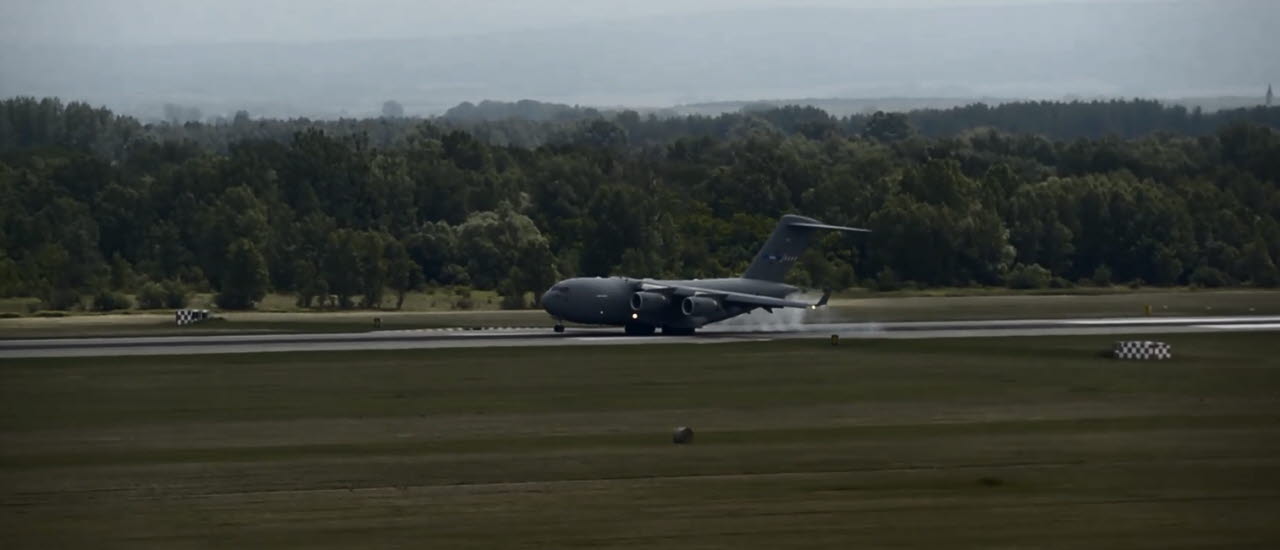
Bartok 28, back in Papá - after 16 500 kilometers, three countries and 12 take-offs and landings.
Photo: Anton Thorstensson/Swedish Armed Forces
Drunk countless cups of instant coffee and told each other increasingly boring jokes during the 21 hours and 52 minutes in the air. A fairly common shift for those working on the Heavy Airlift Wing, all in all.
"When I get home I'm going to do the washing, get a shower and meet an upholsterer to sew some new cushions for my wooden boat," says Filip Däldehög.
"The kids will be at school but my wife will be at home when I get there, just maybe. But probably not. She has never been as busy as she is now," says Robert Fransson.
"I'm going to write a report on the mission and then do some planning ahead of tomorrow's work. Then I'll do a training session. My girlfriend is away, so I don't need to rush home," says Karl-Johan Svensk.
Their shift is now over.
But work on this mission had started much earlier.
FRIDAY 14.02, MISSION PLANNING ROOM, PÁPA:
"Dakar will have to be the alternative."
Honesty is best in the long run. So the truth about Pápa, Heavy Airlift Wing's base, is this: a sleepy town of 33,000 inhabitants in the Hungarian countryside. Right now, though, it is home to the second largest Swedish foreign mission, after the Minusma mission in Mali. And it will be running for a long time - 24 of the 30 years agreed remain. That is how long Sweden will be a part-owner of the three C-17 aircraft. Around twenty-five Swedish Armed Forces employees and their families will be moving here, each for a few years, during that time period. Even though basic things such as schools did not work smoothly to begin with, none of the Swedes that Försvarets forum talk with had any doubts about settling in Hungary for a few years.
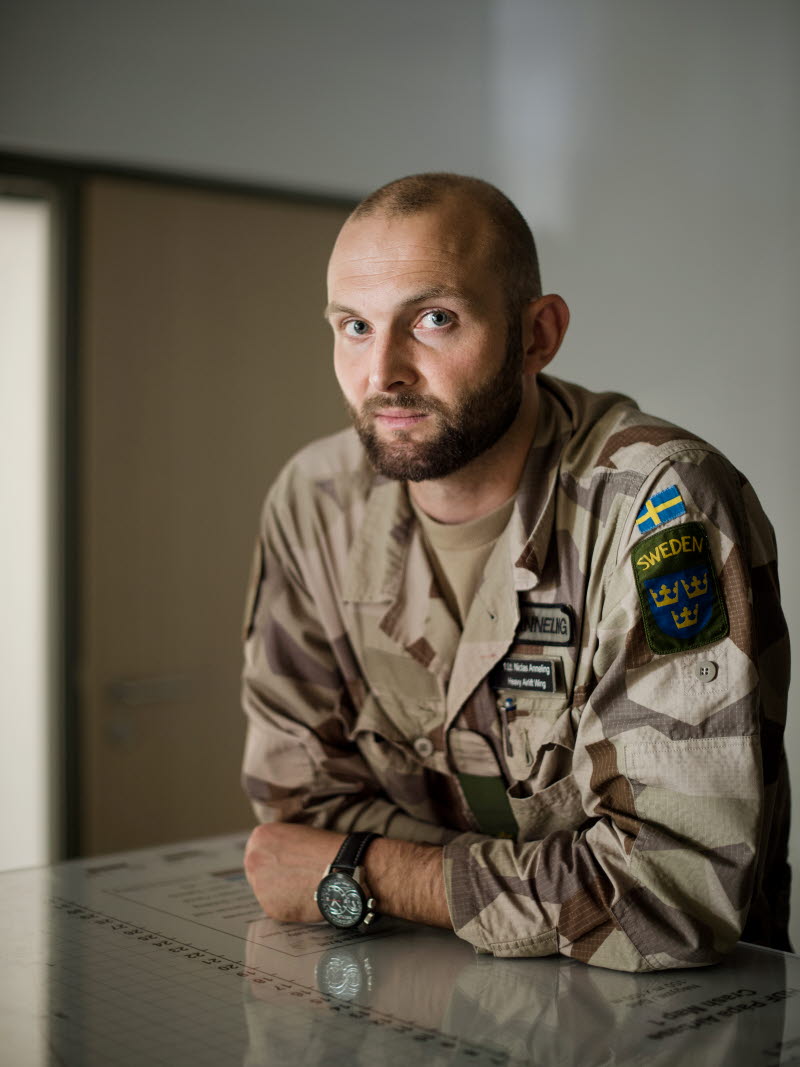
Niclas Annerling works as a planner and is now in his fifth year in Pápa, after being at home for a short period.
Photo: Anton Thorstensson/Swedish Armed Forces
On the contrary, most saw it as a privilege to work in an international environment and to get really good at your main job. On top of this, they could experience a small adventure together with their families.
Niclas Annerling works as a planner and is now in his fifth year in Pápa, after being at home for a short period. He is currently planning Mission 06SWE28B, which is the mission in this article.
"The planning includes everything from upcoming weather forecasts to alternative landing sites. Bamako in particular is a bit tricky. There are no good airports around there, so it will have to be Dakar in Senegal," says Niclas.
Dakar is more than a thousand kilometres from Bamako, or about the same distance as between London and Milano.
FRIDAY 14.23, CURRENT OPERATIONS ROOM, PÁPA:
"It's a large puzzle, but a fun one."
Niclas’s colleague, Peter Mignander, is in the room next door. His title is supervisor. He and representatives from the other eleven countries in Strategic Airlift Capability meet every quarter and make a long-term plan of transport needs for the next four months.
"There is national order of priority, but we try to avoid that by alternating missions so that everyone is as satisfied as possible. We have a total of 3,165 flying hours to distribute between three aircraft, so it is a big puzzle, but fun. And we'll be doing that puzzle 365 days a year around the clock for at least 24 more years," he says, and smiles.
On the three screens on the wall behind Peter, he and the other staff constantly follow how and where the three aircraft are planned to fly in the near future.
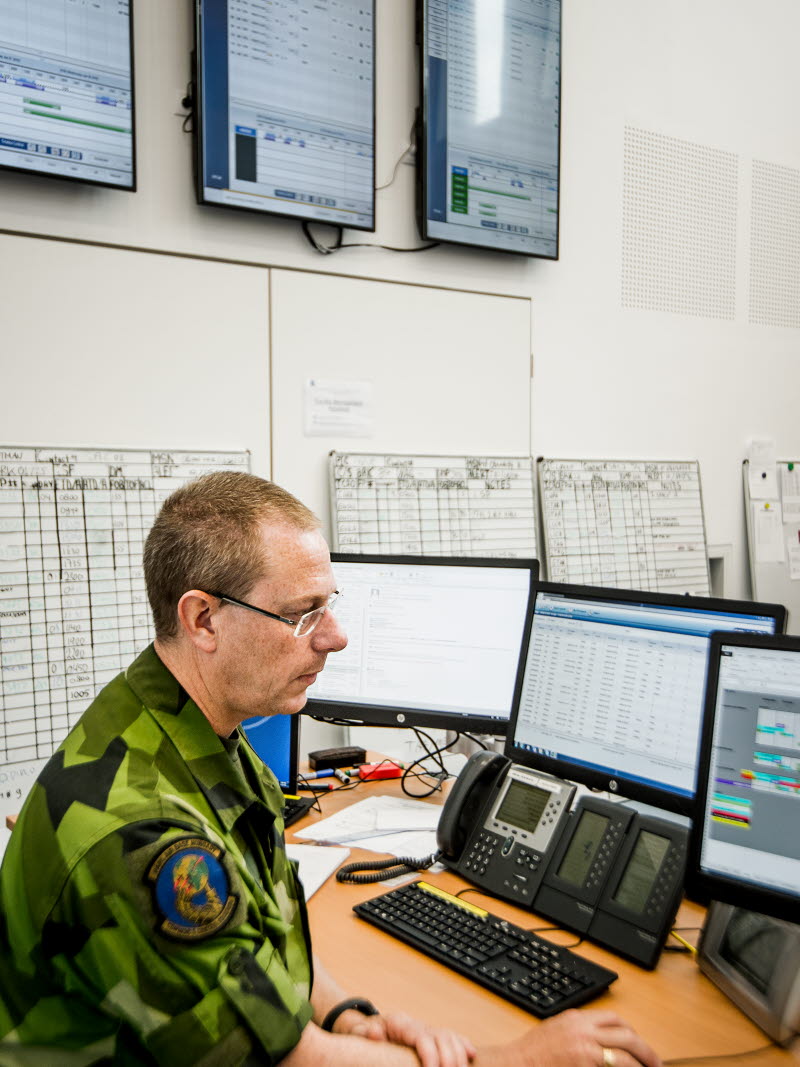
FRIDAY 14.14, CURRENT OPERATIONS ROOM, PÁPA.
All the flights are controlled from here - around the clock, all year round.
Peter Mignander is working as supervisor here.
Photo: Anton Thorstensson/Swedish Armed Forces
"We have a standing joke - we are the airline who flies you where you don't want to go. But unlike normal airlines, we have no fixed routes or timetables. And yet, we at HAW are the C-17 users with the highest performance rating in our missions right now," says Peter.
"And that's not bad, considering that delays and other problems have such large consequences. The three planes we have are the only ones available."
And since many of the flights are to destinations where the weather can be a real bugbear, that achievement is even bigger.
"The aircraft also belong to the Hungarian state, and since Hungary does not have embassies everywhere, applications for diplomatic authorization can be difficult. Every organization that orders a flight must provide accurate information about the load, so that we can apply for the correct diplomatic permits for the route," says Peter.
MUCH EARLIER, SWEDISH ARMED FORCES LOGISTICS CENTRE, STOCKHOLM:
"There will be about 20 round trips to Mali this year"
Work on the mission actually started about six months before the C-17 aircraft took off from Papá. Håkan Ohlsson is a planner at the Transport Office, and one of the staff that match transport needs with the appropriate solutions.
"This year we use C-17 for round trips to the Mali operation, since the need for heavier transport to Afghanistan has stopped. As well as personnel transport, we share one aircraft every third week with Finland, Norway and the Netherlands to transport materiel. It'll be a total of 20 round trips with Swedish loads for the C-17 aircraft this year," says Håkan.
The biggest challenge is inland transport in Mali - the route from Bamako to Timbuktu is a real bottleneck, but Håkan and colleagues at the Transport Office are hoping to find a solution in the future.
"Technically, a C-17 can land at Timbuktu airport, but some of the safety requirements are not met. Hopefully we can ignore this for individual flights. We are working on flying down all the personal equipment for the next changeover of troops directly from Sweden to Timbuktu."
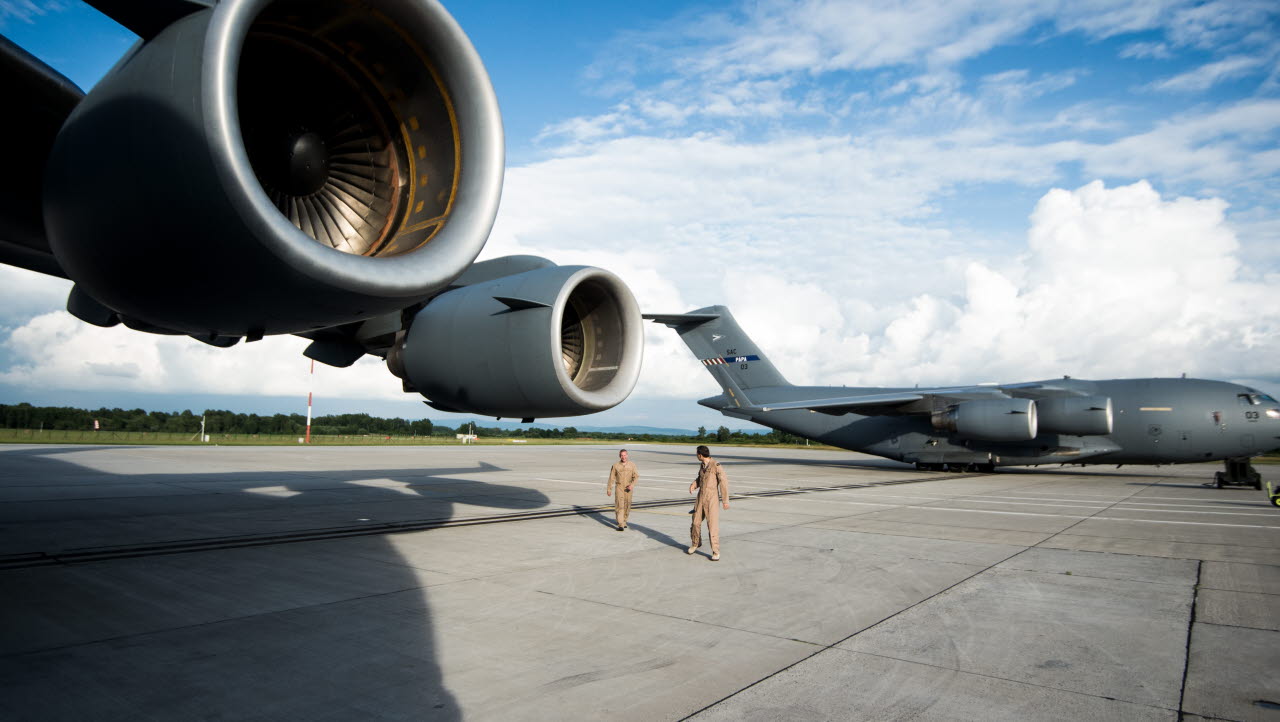
Three C-17's is based in Papá, Hungary.
Photo: Anton Thorstensson/Swedish Armed Forces
MONDAY 03:33, 10 KILOMETRES ABOVE ALGERIA:
"Actually, I was going to work at Volvo".
Below us, total darkness.
Above, a clear and starry sky.
The sounds of Algerian and Nigerien air traffic controllers can be heard in the headphones. There is a Swedish-Slovenian duo of pilots in the cockpit: the captain, Filip Däldehög, and Robi Resnik, jokingly referred to as "The Airborne Cowboy" by Filip.
"Actually, I was going to work at Volvo. That was the plan when I was studying engineering at Chalmers University of Technology. I had always dreamed of flying a rescue helicopter at sea, but I thought it would be impossible. You had to be somebody exceptional to be a pilot. But then I got to know two guys who had applied for and been accepted on flight training with the Swedish Air Force" says Filip.
Filip noted that his new friends were perfectly ordinary guys, and they both encouraged him to apply for the course. He passed the tests, but his dream of becoming a helicopter pilot did not work out; there was no demand in those years.
"I decided to apply for transport aviation instead in the C-17 system. Immediately after flight school and training in the United States, I came to Pápa. And even though I've done it for four years now, it still feels a bit unreal that I am the pilot of this aircraft. Helicopters are still cooler, though."
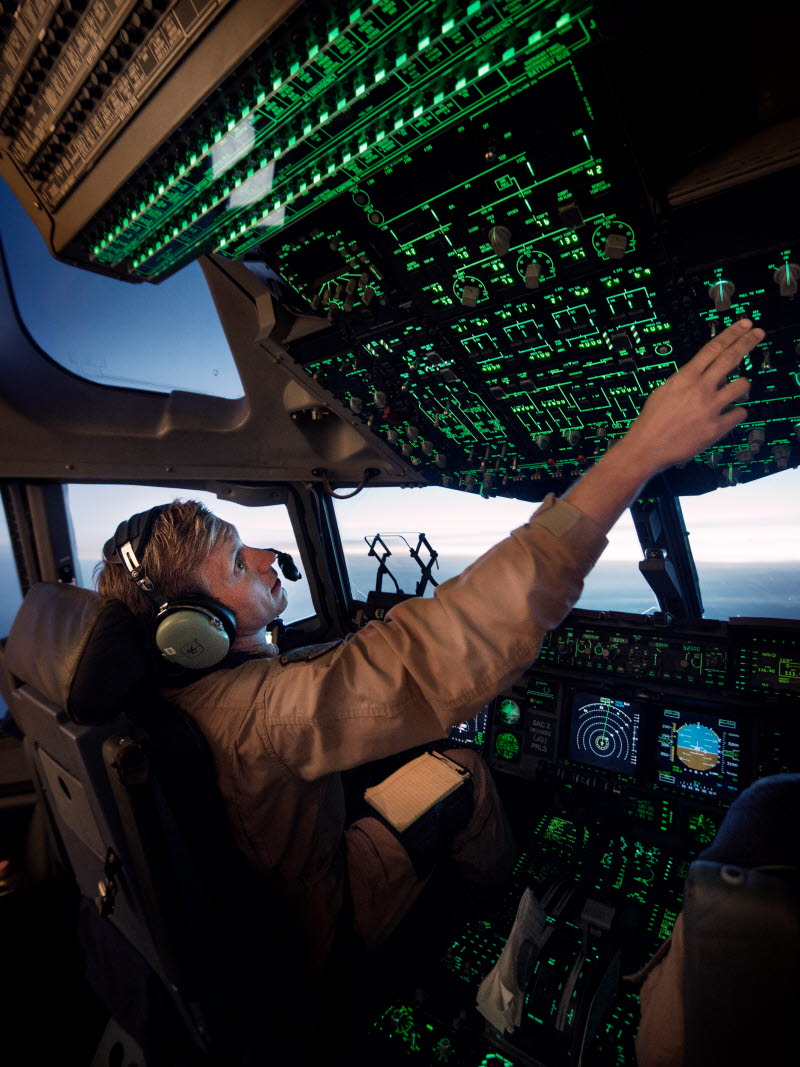
Filip Däldehög was studying engineering at Chalmers University of Technology. He always dreamed of flying a rescue helicopter at sea, but thought it would be impossible, that "you had to be somebody exceptional to be a pilot.".
Now he has been flying C-17's since 2012.
Photo: Anton Thorstensson/Swedish Armed Forces
SUNDAY 21.58, 10 KILOMETRES OVER EUROPE:
"Bartok two-eight, that's us"
The constant radio traffic is short and full of codes. Not so strange, because we are still flying over Central Europe with plenty of civil aircraft around, all in constant contact with air traffic control.
"After a while you learn to only listen for information on our call sign, Bartok 28. Now that we are flying I can relax - that part is easier than the captain's responsibility for the whole of the crew. In that capacity, I have to ensure that all the rules and regulations are followed, such as a load master who reported that he had slept too little before departure. I have to take that into account," says Filip Däldehög.
Communication between the crew over the intercom is also fairly intensive; both between those on the flight deck and down in the cargo hold. Filip is a little envious of one of the load masters, who is taking the time to watch an episode of 'Game of thrones' on his laptop - one that Filip has already seen.
"I envy you. You have so much good stuff to look forward to."
He hands over responsibility to his colleagues Robi and Mark, from Holland, to go down to the aircraft's small kitchenette for a cup of coffee. The kettle there is a joke, he says.
"This aircraft costs about 220 million dollars, but it takes forever to get a cup of boiling water. And the windscreen wipers in the cockpit are absolutely useless," he says with a laugh.
TUESDAY 20.36, AT BAMAKO AIRPORT:
"We flew 5000 bicycles to Afghanistan"
He mostly just stands and looks around, it seems at first glance. But then even the untrained eye notices that Karl-Johan Svensk works hardest when the aircraft is stationary on the ground. He is part of the close range protection for HAW called HAWCS - Heavy Airlift Wing Combat Security.
Their task is to gather surveillance information at the landing sites and, above all, to protect the aircraft. So while the load masters arrange the pallets and the pilots put the next flight into the aircraft's computer, Kalle and his two colleagues, Simon from Norway and Kevin from USA, stand at strategic locations around the plane and make sure that no unauthorized people come close to it.
As the fifth Swede, Kalle did the Phoenix Raven Global Protection Course in the United States - a three-week course where students are drilled for long days doing 70 applied exercises as well as verbal judo.
"It sounds funny, verbal judo, but in fact it was one of the most rewarding parts of the course. I learned different techniques to verbally neutralise, or 'talk over' potential threats. That and the applied exercises were the best things. You can do push-ups anywhere," he says.
During his few years in HAWCS, Kalle has been involved in transporting almost everything, but one thing stands out from the rest.
"It was when we flew down from Örebro with 5000 bikes from a Swedish discount store for an aid project in Afghanistan. I sometimes wonder how many of those bicycles are still being used on the Afghan roads…"
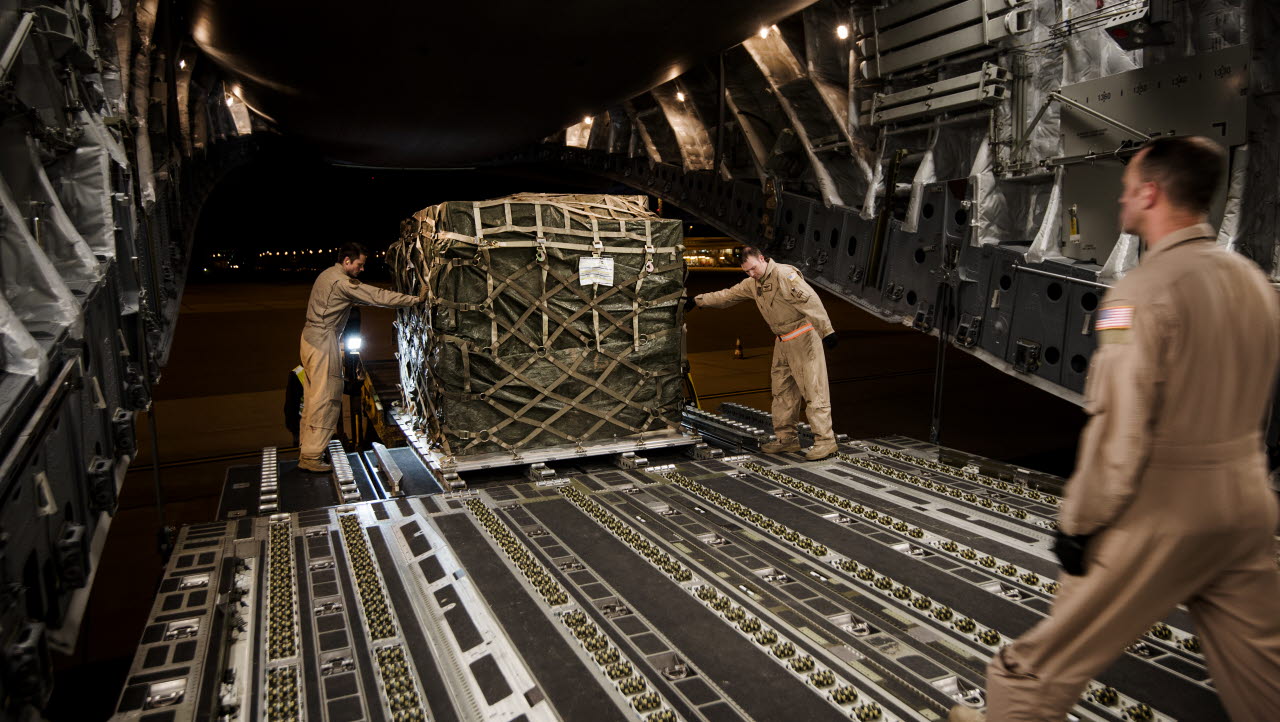
A pallet on a C-17 can load up to 4500 kg. A total of 18 pallets fit in the aircraft.
Photo: Anton Thorstensson/Swedish Armed Forces
MONDAY 10.14, 10 KILOMETRES OVER MAURITANIA:
"The Hercules feels a bit cramped in comparison"
Almost an hour after starting from Bamako, an alarm suddenly goes off in the cockpit: FCC 2, the Flight Control Computer, is on auto pilot but the auto throttle is not functioning properly, meaning that all height, course and speed changes must be done manually.
If another fault should arise, there is the risk that the aircraft's electronic flight system could stop functioning completely. The captain and crew are now faced with two options: continue to Las Palmas and try to solve the problem on the ground there, or turn back to Bamako. The choice is made quickly: Las Palmas. Down in the cargo hold the 50 Dutch soldiers would almost certainly be grateful if they knew. They are on their way home after serving in Mali, with a stop for debriefing on the Canary Islands.
Since the Swedish mission was going to fly there empty, Holland was able buy the hours from
Sweden for its own needs. On Robert Fransson's flight overall it also says FCC - Flying Crew Chief. He used to work on TP84s at Såtenäs, and thought that they were large transport aircraft.
"Then I moved to the C-17 system, and I've got used to the size now so that the Hercules feels a bit cramped in comparison," says Robert, keeping up his concentration with some coffee and raisins after 18 hours' work.
After landing at Las Palmas military airport, the FCC is working again after restarting.
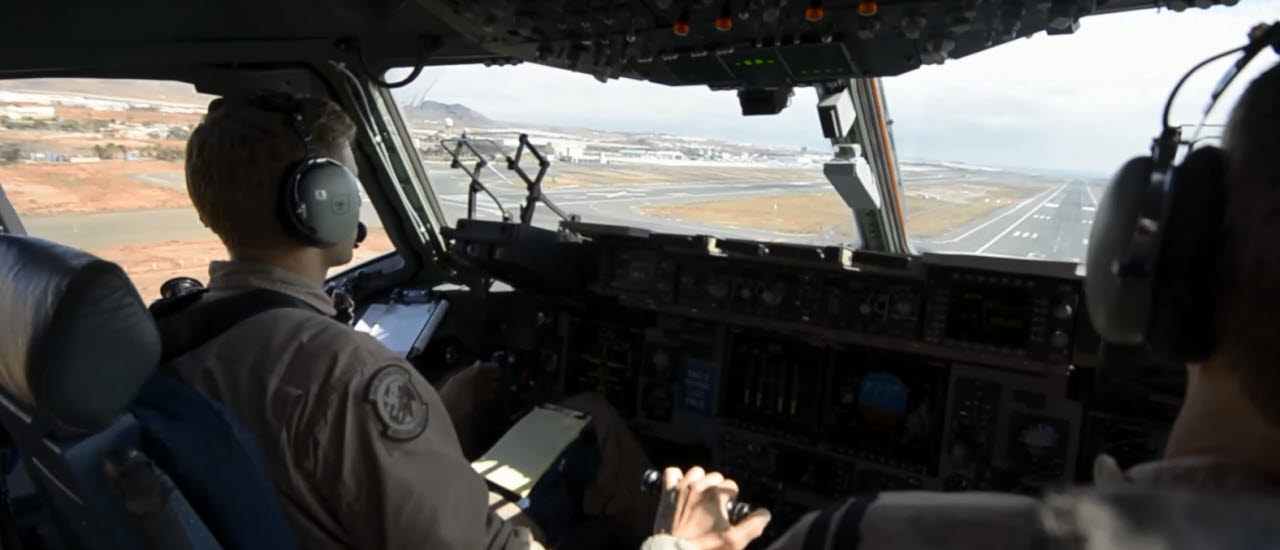
Landing at Las Palmas airport after a four hour flight from Bamako, Mali.
Photo: Anton Thorstensson/Swedish Armed Forces
"There are several computers on board, so there is some redundancy. But sometimes you have to do the same thing as with a normal computer that is being awkward - just press the off-button to fix the problem," says Robert.
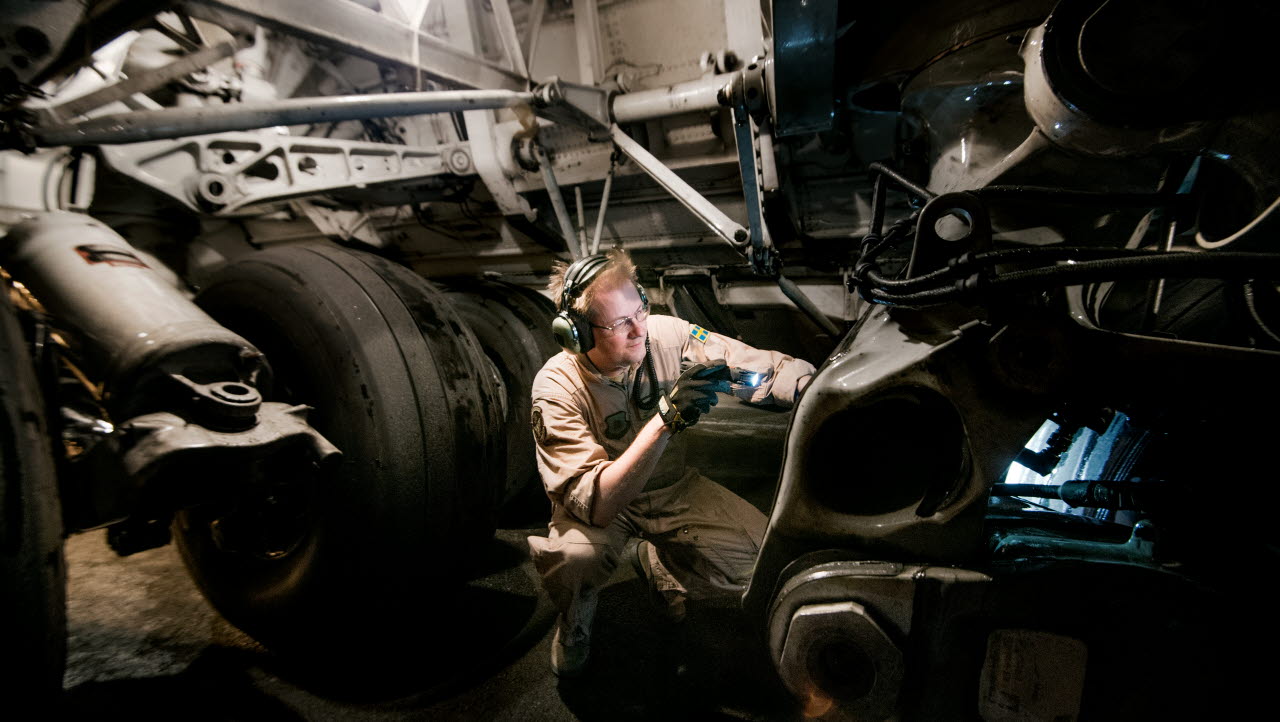
Robert Fransson used to work on TP84s at Såtenäs, and thought that they were large transport aircraft.
"Then I moved to the C-17 system, and I've got used to the size now so that the Hercules feels a bit cramped in comparison," says Robert.
Photo: Anton Thorstensson/Swedish Armed Forces
TUESDAY 17.59, LAS PALMAS AIRPORT:
"The worst breakfast is in Baku"
After the crew has rested for almost 24 hours in the Canary Islands, it is time for the next part of the operation. Hotel accommodation in a place where many Swedes take their holidays may sound luxurious, but Robert Fransson and the others have no time for sunbathing or sightseeing.
"It was a very, very early evening. And I have become quite a connoisseur of hotel breakfasts - we have probably stayed at this hotel ten times now. Where is the worst hotel breakfast? Um, let me see. An American colleague said it was at a well-known hotel chain in Baku, Azerbaijan when we were there. He claimed it was worse than prison food back in Georgia," says Robert and smiles.
Then his smile disappears, because the FCC is still being difficult. It takes a new reboot to get the aircraft's control system working again.
Unlike the delivery of aviation fuel. Despite the order being placed in time and the Spanish supplier promising to be there when the crew arrive, the tankers are nowhere to be seen.
"We'll just have to wait, but it's annoying because we insisted that they would be here when we arrived. It'll take another hour before the tanks are full," says Filip when the tankers finally appear.
There is a huge amount of fuel to be filled.
"At the moment we have only 37,000 pounds, or almost 17 tonnes, in the tanks. We need 220,000 pounds," says Filip.
That is almost exactly 100 tonnes of aviation fuel.
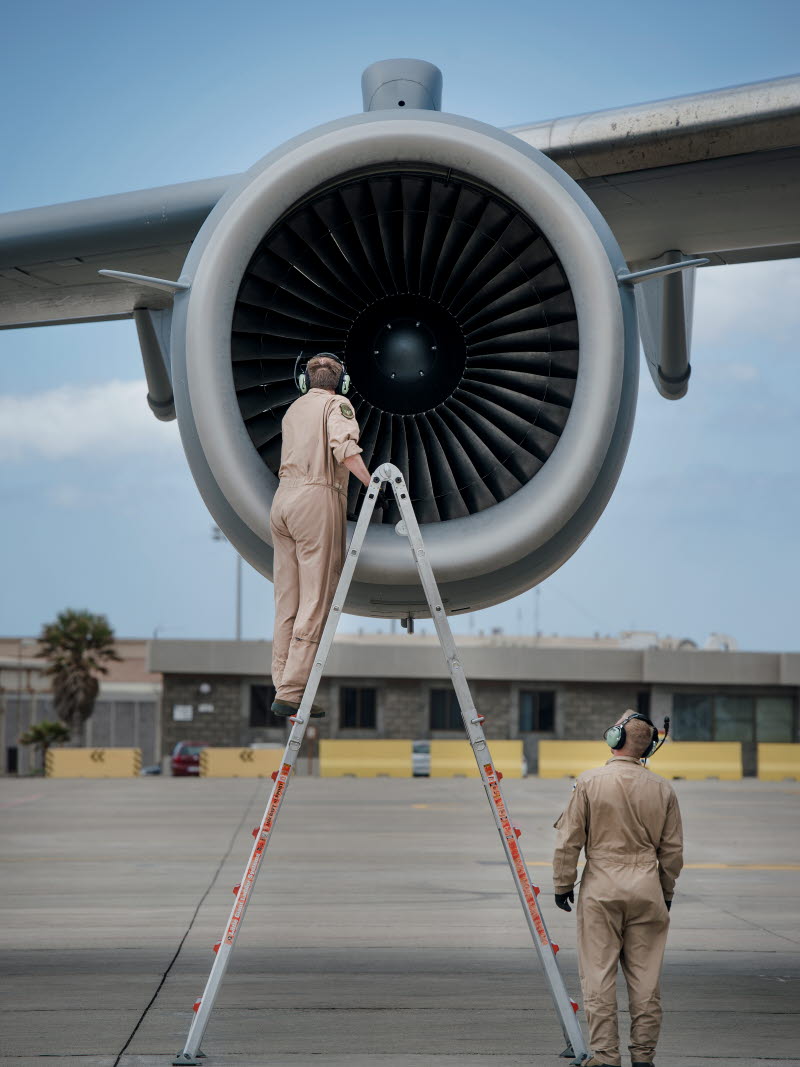
Robert Fransson and Tero Ylikoski checks the engines before take-off from Las Palmas.
Photo: Anton Thorstensson/Swedish Armed Forces
TUESDAY 23.51, 10 KILOMETRES OVER THE MEDITERRANEAN:
"No, you are NOT allowed to smoke on the ramp"
As soon as the "FASTEN SEAT BELTS" signs have gone out, every last centimetre squared of floor space is used in the hold of the aircraft. Mali03 is an travel-experienced bunch, who intend to sleep through this flight as comfortable as possible. Sleeping mats are blown up, everything soft becomes a temporary mattress and the soldiers lie down all over the place. Kalle Svensk is standing by the crew's kitchen with a cup of coffee, watching over the process.
"Swedes, and for that matter Scandinavians in general, tend to do this. American soldiers mostly stay in the rather uncomfortable seats and look like they are suffering," he says and smiles.
"It is maybe a sign of how our different armed forces work: Scandinavians believe in mission-type tactics, and on the other side of the Atlantic they do nothing unless it is an order or explicitly allowed."
What is definitely not allowed is smoking on board, for obvious reasons. That didn't stop one participating nation's soldiers from going back to the ramp and lighting up.
"They were given a very clear lecture on why it was not permitted," says Kalle with a wry smile.
WEDNESDAY 08.43, KARLSBORG AIRPORT:
"The bags of Polly are for my children"
In Karlsborg, Mali03 arrives in drizzle, but Colonel Dag Lidén, the K3 regiment commander, meets every dusty, tanned soldier with a handshake and a smiling "Welcome home!".
Kalle and Simon disappear for around 15 minutes and return with ten or so grocery bags, filled with precious hard currency in Pápa: Béarnaise sauce. Turkish Pepper candy. Polly chocolates. And curd cheese. In fact, an entire cooling box is filled with this protein-rich dairy product, which is very popular among those who train a little more than average.
"My children will each have a bag of Polly chocolates. It gets me a lot of daddy-points," says Robert and laughs.
Having the whole world as their workplace, the crews are able to buy things from their own countries that just don't exist in Hungary.
When the crew left the HAW building just over two days ago, there were a lot of grocery bags on the loading platform. Filip casts a glance at the bags and notes that the mainly American crew has been back the United States: you can tell from the colourful breakfast cereal packets and beer brands that are not sold in Europe. But perhaps the most Swedish of Swedish goods is not in the bags: sweet, salty cod caviare in a dark blue tube.
"It is possible to buy it at a certain Swedish furniture store in Budapest, Vienna and Bratislava," says Robert.
Simon, from Norway, says nothing.
He is too busy making a hearty prawn sandwich for breakfast.
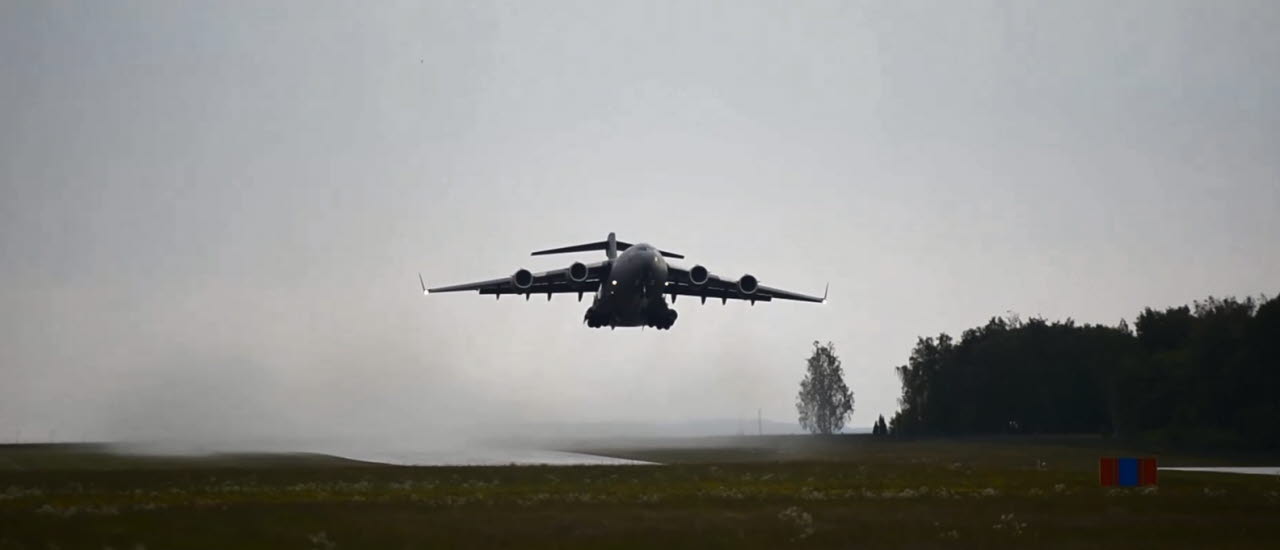
Take-off from Karlsborg after dropping off Mali03.
Photo: Anton Thorstensson/Swedish Armed Forces.
WEDNESDAY 10.51, PÁPA AIR BASE:
"Thanks guys, until next time!"
The 128 tones of aircraft - excluding cargo and fuel - is landing at its home base, maneuvered by the Slovenian pilot Robi Resnik. After taxiing and transfer to the Boeing staff who take over responsibility for the aircraft and the loading of countless bags with both private and work gear - for the sake of simplicity, let's just say that there are quite a few guns on board these flights - into the minibus, the crew walk towards the Heavy Airlift Wing's newly built office and operations centre. After staying six years in the old Hungarian barracks, all the operations are in one and the same building; not lavish, yet quite stylish and Scandinavian.
By the loading platform we meet another crew, whose mission is probably in Europe or USA - a guess based on their flight suits being olive green instead of sand-coloured.
Only two hours after Filip, Robi, Mark, Joshua, Chris, Robert, Tero, Kalle, Simon and Kevin have parked the C-17 aircraft after mission number 06SWE28B C-17 aircraft, it takes off again.
With a new crew.
Towards new goals.